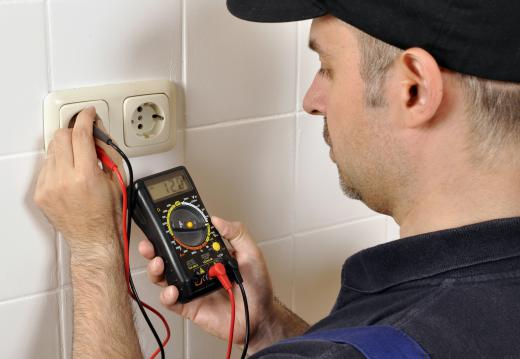Voltage measurement is done in many applications by use of a voltmeter, which is a hand held device that measures the potential or voltage difference between the positive and negative terminals that are placed in contact with locations in a conducting electrical circuit. Since voltage is defined as this potential difference between two points in a conducting circuit, there are many circuits that have a built in voltage measuring capacity as well. Voltage is defined as the electrical difference between two points in a circuit that carries a current of one ampere and the work energy of one watt, and is an essential feature of any electrical device.
When a measurement of voltage takes place, if the readout indicates a positive value, that means that the voltage measurement device is displaying the true nature of current flow within the circuit, from the positive lead through the voltage measurement device to the negative lead and back into the circuit. If the voltmeter indicates a negative value, that means the positive and negative leads are reversed and current is actually flowing in a reverse direction. Regardless of how the leads of a voltmeter are placed at points in a circuit, voltage measurement is an indicator of a potential difference only, at two points in a circuit, and is strictly speaking a variable measurement, and not one of actual current flow.

Current flows from positive to negative potential in a circuit. Voltmeters indicate this as a positive value on readouts. It is also true that the actual physical flow of electrons in circuitry is in the opposite direction from negative to positive, as the counterbalancing effect of current flow. Voltage measurement is often confused with current flow, but current flow is actually measured in amperes, while voltage can be seen as a snapshot in time of a difference in electrical potential at two points in a circuit.

As a voltage measuring device works, it also redirects some of the current in a circuit in the process of measuring it through the unit. This modifies the actual voltage of the circuit while the voltmeter is attached. Most voltmeters are built to have a very minor effect on circuit performance during such measurements, however.
Other types of external and built-in circuit devices that measure voltage include the oscilloscope and analog-to-digital converter (A/D) cards in computers. Some devices also measure more than just voltage, such as combined voltage current measurement, or the resistance of a circuit, and these units are referred to as multimeters. Many modern versions of voltage-measuring devices are digital and provide one discrete readout value, and, in the case of multimeters, are referred to commonly as digital multimeters (DMMs).

Early forms of voltmeters were built on the analog principle of a continual measurement of a voltage value, and had a graduated gauge with a needle that would fluctuate up and down as voltage changed. In this regard, they resemble, to some degree, the readout of an oscilloscope, which produces a graphical display of the continuous measurement of voltage over a set time period. Computers utilize A/D converters to measure voltage and change the measurement to a binary signal that the computer understands. These devices also take the true input voltage in terms of an analog signal, and change it to a digital value that software on the computer can analyze.
